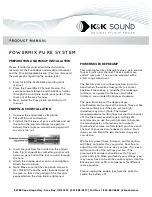
UNAOHM
EP2500 (Rev. 0)
55
12.4.2
QPSK MER Measurement
MER
is the merit factor for digital signal quality. Its measuring range spreads over 5 to 20 dB. The
better the signal the higher the MER. Besides, MER is particularly useful for LNB skew and cross-
polarization optimization.
12.4.3
QPSK RU Count (Reed-Solomon Uncorrected)
This last parameter, gives an idea of the quality of the signal over long periods of time. In particular, it
is possible to observe the loss of signal “blocks” that appear on the TV-picture as corrupted pixels
(image pixellation) or mosaics effect.
RU (Reed Solomon Uncorrected - Identified errors that are not corrected) is a register that increases
precisely when these events occur.
Naturally, the worse the BER is, the more rapidly the RU will increase.
The value of the register is increased from 0 to 65535 and is blocked at the maximum value. It is reset to
zero each time there is a track loss of the signal, a retuning or a change in the setting of the attenuator.
This register gives an idea of the quality of the installation if controlled for long periods of time.
Its increase depends in fact on the corrections carried out in the “Reed Solomon” stage but these are
already numerically very low when the “Channel BER” is around 1E-3 (in the order of one increase
every 30 minutes).
A very simplified flow chart of the digital signal is shown in Figure 24.
12.4.4
Summary
We resume the above-mentioned points as follows:
1) There is no relationship between the quality of the picture and the quality of the digital
signal.
2) The most important and practical quality index is the CH BER.
3) The BER evaluation may be carried out only after all the phases of the receiver up to the
error corrector have tracked the signal.
4) In order that all the stages may lock the signal the variable transmission parameters (Channel
frequency, Spectrum, Symbol Rate, Code Rate) must first have been correctly set.
12.5
OFDM MEASUREMENTS
OFDM is the name of the transmission system adopted in Europe for the “on air” transmission of digital
data and TV signals. In synthesis, the features of this system are:
•
The channel frequency occupancy is the same as that of the analogue transmissions currently in use.
•
The possibility of transmitting various programs in different combinations on one single channel,
approximately from four good quality ones to eight of inferior quality, with different intermediate
combinations.
•
Reduced transmitter power requirement.
•
High resistance with respect to echoes and multiple paths.
•
The possibility of optimized transmitting for reception by installations with a fixed roof antenna,
with an internal antenna or by motor vehicles.
•
The facility in transmitting any type of data, such as program menus, different audio channels
simultaneously, subtitles in different languages.
The OFDM is characterized by the simultaneous transmission of an elevated number of carriers, two or
eight thousand, each one having its own digital modulation. The carriers are not really generated and
modulated individually: mathematical algorithms generate the carrier modulation, which initially is a











































